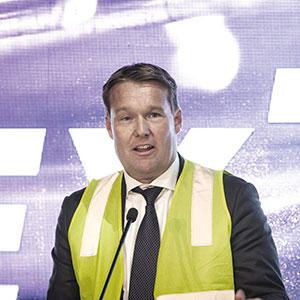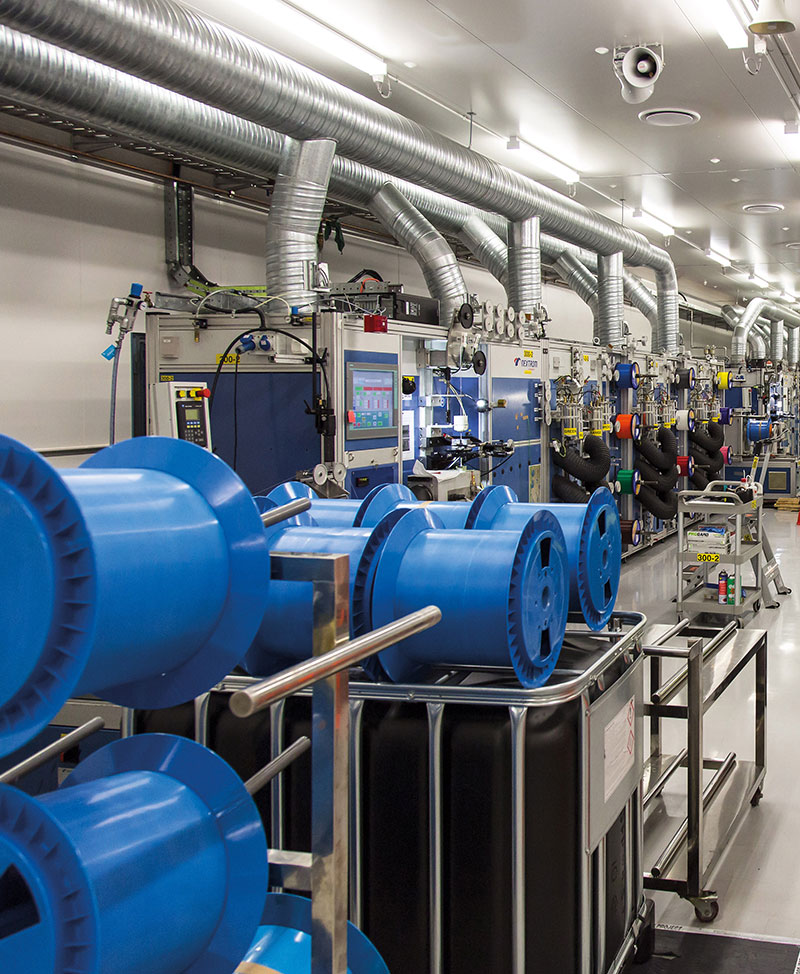The Australian way
Global scenario
The australian way
A CONTINENT-WIDE REACH
500 employees - 9 warehouses - 3 manufacturing facilities
With more than 500 employees, 9 warehouses and 3 manufacturing facilities, Prysmian Group exhibits a strong industrial and commercial presence in Australia and New Zealand. Seven manufacturing warehouses are located in Liverpool and Dee Why, Australia, and one in New Lynn, New Zealand, with a combined production capacity of 70,000 cable tonnes. The operations span six business units: Construction, Telecom, Industrial Markets, Power Distribution and Power Transmission. Australia and New Zealand are also important centres for R&D with AUD 5.5 million invested per year.
Frederick Persson, CEO of Prysmian’s ANZ business, explains how the Group managed to secure and successfully carry out the National Broadband Network project, a monumental milestone in the field of broadband connection. But the story he tells speaks of successes that go beyond the telecom field.

The main challenge related to changes in the c ustomer forecast. Our customer’s cable demand changed very quickly and we had to react and adapt in real time to those changes. I am happy to say that we have been able to support them successfully.” Frederick Persson, CEO of Prysmian Australia and New Zealand (ANZ), does not hesitate when asked what has been the key to success in the National Broadband Network (NBN) project in Australia, that aims to bring broadband to premises in every corner of the nation.
As Frederick says, Prysmian had to adapt to the client’s developing needs in many different aspects. Particularly challenging was the fact that some of the production was carried out in China, 11 hours flight away, and also in Europe, which is even further. “We needed to be constantly available, keeping in touch with our facilities abroad, while being attentive to our customers at home.” But maintaining the customer fast pace wasn’t the only challenge encountered and overcome in the NBN project.
“A major technical issue was the duct space, which was very limited,” continues Frederick. In simple terms, Prysmian’s Technical team encountered ducts that were crowded due to the number of cables inside them and needed to find a solution to make room for all of them. In response, they managed to change the cable design in order to maximise duct occupation. Eventually, they reduced the diameter of the cables by around 35%, and so the space required to insert them was much smaller than two years ago.
“This was highly appreciated by NBN. We developed the solution while creating a completely new cable, adapted to their particular problem. This has been a strong point of differentiation for us,” says Frederick.
We have been extremely successful in accommodating our customers’ needs very quickly”.
“In terms of our approach, we are very focused on local quality and simplicity; we want to be a very simple company to deal with. So customers see we react quickly, we are flexible and we are predictable, which makes us reliable.”
“What is very special for us down here,” Frederick goes on, “is that we are very focused on sales, and the commercial team is driving the company strategy. A bit more, perhaps, than in other ‘typcial’ Prysmian regions.” On the telecom side of the business, Prysmian ANZ has carried out several developments, drawing on the local needs for specific types of cable, and has been very good at adapting, quick in developing new cables, quick in manufacturing them, and quick in creating even smaller cables.
“I think one peculiarity of our presence here is our local development capability on the telecom side, and the ability to be easy to deal with. We keep it as simple as we can,” he states. And that is certainly why the NBN project, launched by the Government in 2010, was awarded to Prysmian. “I think we have been extremely successful in accommodating their needs very quickly,” Frederick says.
We are very focused on local quality and simplicity; we want to be a very simple company to deal with”.
Could this success story pave the way for similar ventures in other countries? “I’m sure that there are things to be learned from our experience here, most of all for the scale of the project which was enormous – 24 million people in the entire continent.” But Australia is not just telecom. In this resource-rich country it may seem quite obvious that Prysmian plays a role in the mining industry as well. “Mining cables are a very specific product, since the Australian regulations about mining are probably the most restrictive in the world, and much more complicated, so our mining cables are made for very special applications.” Frederick explains. Mining cables are, in fact, exposed to a tremendous amount of mechanical stress and subjected to very rough treatment in the mines and, consequently, have a very short lifetime. This makes performance extremely important, because if the cable has problems and the mine cannot operate, the financial consequences are enormous.
“We are very well known for being a solid producer of mining cables and we are strong in the market; our price is high since the cables are complicated,” Frederick tells us proudly. And being strong in mining is also a plus in other fields. Australia saw a boom in raw materials, but when the price of oil went down a year and a half ago, investment was scaled down. So Prysmian turned to the infrastructure market where tunnels, roads, and the like are dependent on a seamless supply of cables. Thanks to the Group’s mining expertise which yielded a reputation of being a top-quality and reliable supplier, the company was able to reach out to the leading businesses in this sector as well.
Returning to the NBN project, which is in its final stage to completion, Frederick notes that,
“It is proceeding well. We have supplied around 75-80% of the total volume of cables needed and we have been very good in supporting the project all the way through.”
In conclusion, Frederick explains how Prysmian ANZ approaches its markets:
“We developed a local website for commercial purposes (prysmiancable.com.au) and have also worked a lot on our brand, connecting the Prysmian commercial brand to the products we sell. We tried to be attractive using the typical Prysmian magenta color to create a connection with the cables we make and have been using that in a very consistent way. This has helped us create a strong identity here in Australia.”
LARGEST APAC FIBRE MANUFACTURER

4.5 hectares area
3 million fibre-km of optical fibre
600,000 pair-km of copper cables
The Dee Why factory in New South Wales is the largest fibre optic manufacturer in the Asia Pacific region. Established in 1968, the facility lies on a 4.5 hectares area where some 145 qualified employees are at work. It produces telecom, optical fibre and copper cables with a total annual capacity of 3 million fibre-km of optical fibre and 600,000 pair-km of copper cables.
MINING: WHERE PRYSMIAN MEANS SAFETY
Prysmian cables are known for being the safest and most reliable, even in extreme adverse conditions. The mining industry in Australia perhaps provides the ultimate test to this worldwide recognition. Prysmian cables are indeed designed to withstand the most extreme Australian conditions such as ozone, high-speed, oil and fuel, mud, moisture, acids, bases, rodents, and UV irradiation, as well as extreme low and high temperatures.
As a result, Australian and New Zealand coal mines are some of the safest in the world, a record built on strict controls and legislation that ensures cables used for mining equipment and in in hazardous areas are of particularly high quality, such as those provided by Prysmian. Also open-cut and surface mining in the Oceania region present challenges unique to the world, such as extreme UV exposure, tropical downpours, high-wall suspension installations and the like, and so careful cable selection and fit-for-purpose products are a must. Prysmian cables are fully compliant to the strictest controls and legislations in the world.
